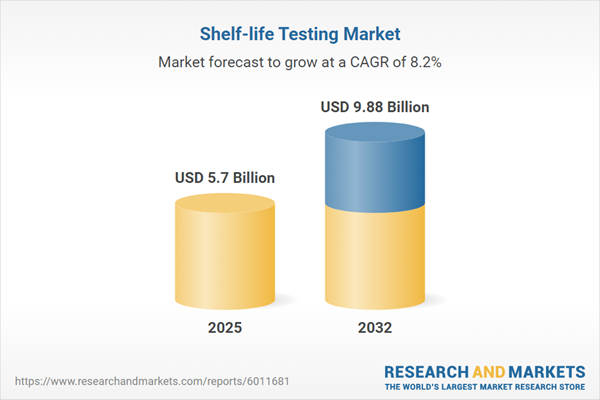Speak directly to the analyst to clarify any post sales queries you may have.
The shelf-life testing market empowers senior leaders to strengthen product quality, ensure compliance, and reduce risk across evolving global supply chains. As regulatory requirements and market expectations change, shelf-life testing has become integral to effective executive decision-making and supply chain resilience.
Market Snapshot: Shelf-life Testing Market Overview
Shelf-life testing continues steady expansion, driven by globalization and the demand for precise product validation. Growth in the food and beverage, cosmetics, and pharmaceutical industries is spurring adoption of sophisticated analytical technologies that optimize the consistency and longevity of finished goods. Service providers differentiate by offering digital platforms and real-time monitoring, allowing prompt risk assessment and adaptive quality processes. Organizations aiming for future-ready operations increasingly leverage shelf-life testing to advance quality and supply chain strategies, with technology-driven adoption supporting market development and cross-sectoral integration.
Scope & Segmentation
- End-Use Industry: Shelf-life testing solutions are customized for the cosmetics, personal care, pharmaceutical (spanning branded and generic), and food and beverage industries. Specialized protocols also address bakery, dairy, meat, confectionery, and poultry products, each with distinct safety requirements and regulatory landscapes.
- Packaging Material: Services include testing for glass (Types I, II, III), metals such as aluminum and tinplate, a range of paperboard varieties, and plastics including HDPE, PET, and PP. Package integrity assessments support compliance and minimize risk for each packaging material.
- Storage Condition: Analytical methodologies are designed to validate performance in ambient, refrigerated, and frozen conditions, providing robust testing adaptable to diverse global logistics systems.
- Testing Method: The market delivers both accelerated and real-time laboratory processes, utilizing a combination of chemical and microbiological analyses. This approach produces comprehensive data to support executive oversight and supply planning.
- Geographical Coverage: Shelf-life testing services are accessible in the Americas, Europe, Middle East, Africa, and Asia-Pacific. Custom compliance support is available in markets such as the United States, Germany, China, and Brazil, accommodating distinct local regulatory demands.
- Key Companies Profiled: Leading market participants include Eurofins Scientific SE, SGS SA, Bureau Veritas SA, Intertek Group plc, Mérieux NutriSciences, TÜV SÜD AG, ALS Limited, Underwriters Laboratories, NSF International, and QIMA Limited. Their focus on digitalization, traceability solutions, and workflow automation enhances secure, transparent results delivery for clients worldwide.
Shelf-life Testing Market: Key Takeaways for Senior Decision-Makers
- Integrated shelf-life testing solutions enable simulation of full supply chain stages, helping multinational operations strengthen risk controls and support consistent quality in all regions.
- Combining rapid and real-time testing allows for immediate identification of vulnerabilities and supports agile adjustments in production and inventory strategies.
- Advanced microbiological and chromatographic technologies enhance responsiveness to regulatory shifts, ensuring quality standards meet or exceed the requirements of major industries and markets.
- Implementation of digital monitoring and sensor-based systems supports seamless adaptation to regulatory changes while maintaining up-to-date workflow alignment.
- Diverse regional networks and automated testing platforms reduce supply disruptions, empowering organizations to respond efficiently to dynamic compliance environments.
- Standardized protocols and cross-sector collaboration promote operational efficiency and help streamline compliance management across multiple product lines.
Tariff Impact: Navigating 2025 US Policy Shifts
U.S. tariff adjustments are increasing costs on imported packaging and laboratory equipment, prompting organizations to revisit sourcing approaches and invest in domestic shelf-life testing. Modernized digital systems enable accelerated project execution and reinforce product quality as well as operational resilience, helping organizations maintain continuity during regulatory transitions.
Methodology & Data Sources
Primary interviews, targeted secondary research, and direct engagement with operational sites underpin this analysis. Methods include chromatographic, spectroscopic, and microbiological testing. Independent review ensures the impartiality and rigor of the findings.
Why This Report Matters
- Benchmarks offer senior leaders actionable guidance for risk management, process efficiency improvement, and continuous quality enhancement across diverse operations.
- Targeted recommendations equip organizations to prioritize compliance, invest strategically in automation, and align packaging strategies with market requirements for sustainable growth.
- The report delivers evidence-based insights, preparing senior decision-makers to proactively address regulatory and market developments and maintain operational readiness.
Conclusion
Shelf-life testing remains fundamental for ensuring product integrity, safety, and regulatory alignment. As technologies continue to advance, sustained executive focus on testing will underpin enterprise competitiveness and market readiness.
Additional Product Information:
- Purchase of this report includes 1 year online access with quarterly updates.
- This report can be updated on request. Please contact our Customer Experience team using the Ask a Question widget on our website.
Table of Contents
3. Executive Summary
4. Market Overview
7. Cumulative Impact of Artificial Intelligence 2025
Companies Mentioned
The companies profiled in this Shelf-life Testing market report include:- Eurofins Scientific SE
- SGS SA
- Bureau Veritas SA
- Intertek Group PLC
- Mérieux NutriSciences, Inc.
- TÜV SÜD AG
- ALS Limited
- Underwriters Laboratories, Inc.
- NSF International
- QIMA Limited
Table Information
| Report Attribute | Details |
|---|---|
| No. of Pages | 189 |
| Published | November 2025 |
| Forecast Period | 2025 - 2032 |
| Estimated Market Value ( USD | $ 5.7 Billion |
| Forecasted Market Value ( USD | $ 9.88 Billion |
| Compound Annual Growth Rate | 8.1% |
| Regions Covered | Global |
| No. of Companies Mentioned | 11 |









